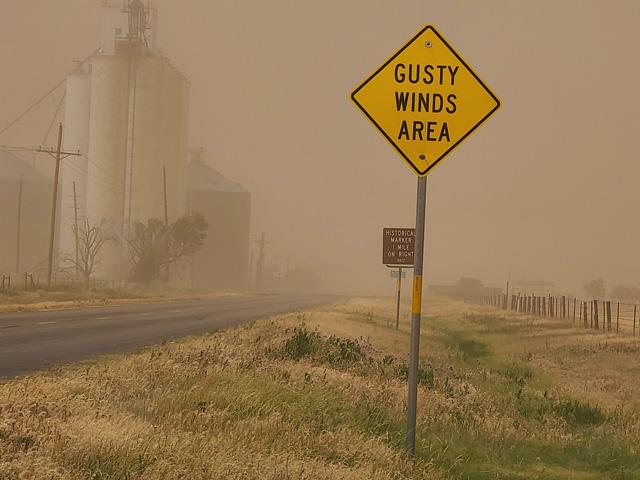Liability and Dust-Related Accidents
Can a Farmer Be Held Liable if Blowing Dust From Their Field Causes a Highway Accident?
MT. JULIET, Tenn. (DTN) -- More than 70 vehicles crashed along a six-mile stretch of Interstate 55 in Illinois on Monday, May 1, as wind gusts in excess of 35 mph whipped up dust from nearby fields, dropping visibility to zero. Seven people died and 37 more were transported to hospitals.
The scale of the tragedy garnered national news attention, and the role of dust from freshly tilled and planted fields played a starring role. While tragic, accidents caused by blowing dust are not uncommon. What is uncommon is farmers being sued over the result.
Lawsuits involving dust are typically nuisance lawsuits, said Rusty Rumley, a senior staff attorney at the National Agricultural Law Center. For example, one neighbor sues another neighbor because blowing dirt from their neighbor's property inhibits their ability to enjoy or use their own property.
It's much rarer for dust to be the issue in a negligence lawsuit. "Negligence is the tort everyone knows about. If you get in an auto accident, and you sue, it's for negligence," Rumley told DTN in a phone call.
In negligence suits, plaintiffs must prove the defendant failed to act reasonably under the circumstances. "It's basically for failure to do what an ordinary, reasonable, prudent person would have done under similar circumstances," he said.
Tiffany Lashmet, author of the Texas Ag Law Blog and associate professor with Texas A&M AgriLife Extension, said negligence lawsuits are very fact specific. Using the recent dust storm in Illinois as an example, a potential plaintiff would have to prove that the farm practices related to planting were unreasonable.
P[L1] D[0x0] M[300x250] OOP[F] ADUNIT[] T[]
"This time of year in Illinois, is it reasonable to be working the ground? Obviously," she told DTN. In this type of situation, a lawyer may turn to the local Extension service to explain what a reasonable practice is in the area, Rumley said.
The other element plaintiffs must prove is causation. In one Texas case, a motorcyclist sued a greenhouse owner after getting into an accident amid a dust storm. The greenhouse owner cleared all vegetation around the greenhouse, leaving the land bare, and the motorcyclist argued the unnatural state of the land led to the dust, which caused the accident.
The court sided against him after police testified that it was the worst windstorm they'd seen and that visibility conditions were greatly reduced in other parts of the town.
"How do you prove it was the dust around that greenhouse that caused the accident versus the dirt blowing from every other farm in the county? That's very difficult to do," Lashmet said. You can read more on the specifics of the Texas case law here: https://agrilife.org/….
In a situation such as the Illinois dust storm, assigning causation would become a practical issue as much as a legal one, Rumley said. "You couldn't go in and say 3% of the dirt came from Farmer A. Six percent of the dirt came from Farmer B."
While the legal bar to a successful negligence lawsuit is high, that doesn't mean a farmer can't be sued over blowing dirt if it were to cause an accident. Both Rumley and Lashmet said there could be scenarios with a unique set of facts where a lawsuit could win at trial.
"What I tell my students is anybody can sue anybody else at any time for anything. Basically, anything a lawyer is willing to file a complaint on, you can do. That doesn't mean it won't get dismissed pretty quickly," Rumley said.
Lashmet said that sometimes, people just want to point fingers. "Just because they didn't farm it the way I would have farmed it, doesn't usually make it illegal," she said.
Landowners should check to make sure their liability insurance policy provides coverage for accidents, such as those caused by dust storms or cattle in the road. Rumley suggests getting those specifications in writing.
Lashmet also suggests making sure their coverage level is sufficient for the risk.
"The other thing I always tell people is to think about your actions against this reasonable person standard. And the thing is, most farmers are probably thinking about this anyway, because blowing dirt is a problem for them as well from an erosion and agronomy standpoint."
For a more detailed look at the meteorological conditions that contributed to Monday's dust storm in Illinois, please read "Local and Large-Scale Weather Factors Created Illinois Wind Machine" here: https://www.dtnpf.com/….
Katie Dehlinger can be reached at katie.dehlinger@dtn.com
Follow her on Twitter at @KatieD_DTN
(c) Copyright 2023 DTN, LLC. All rights reserved.




